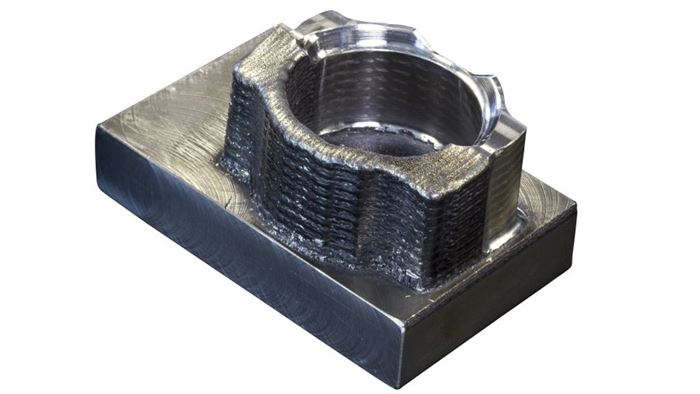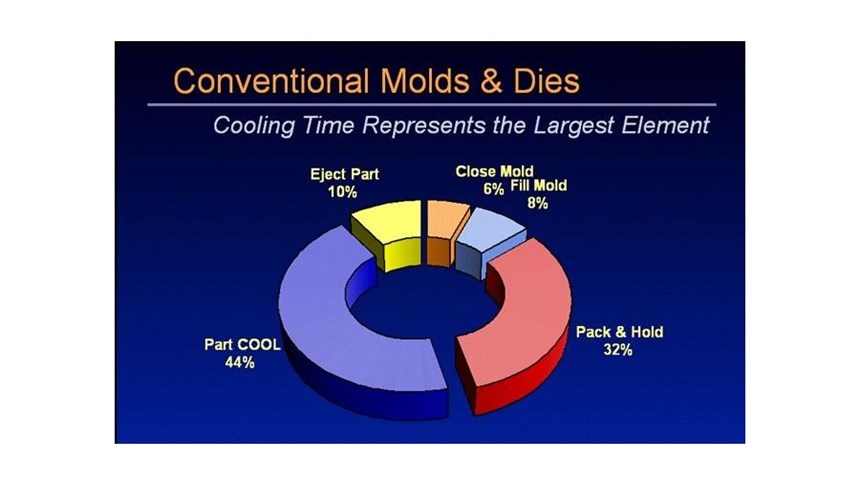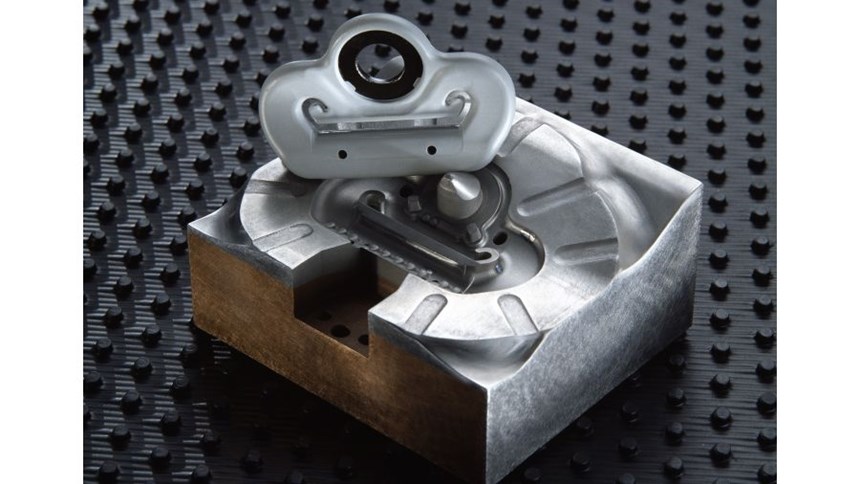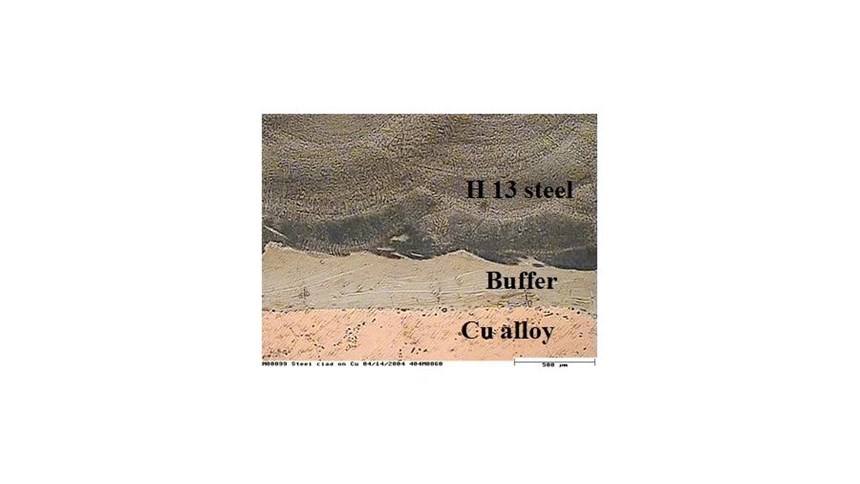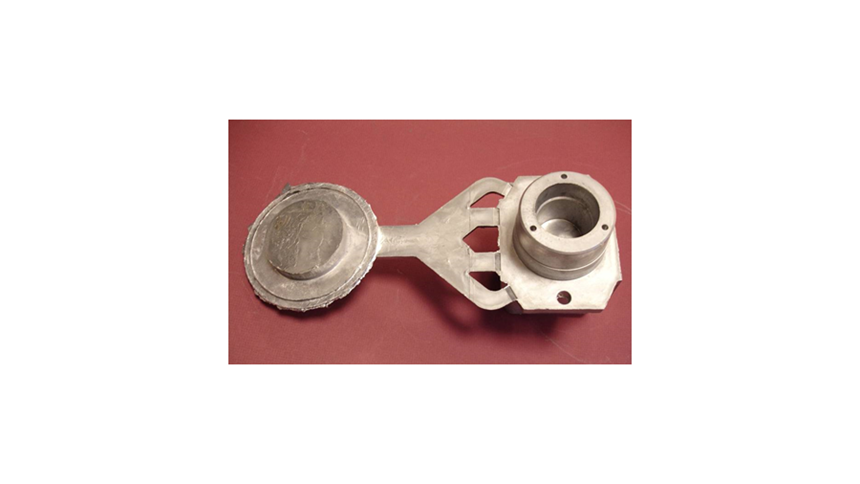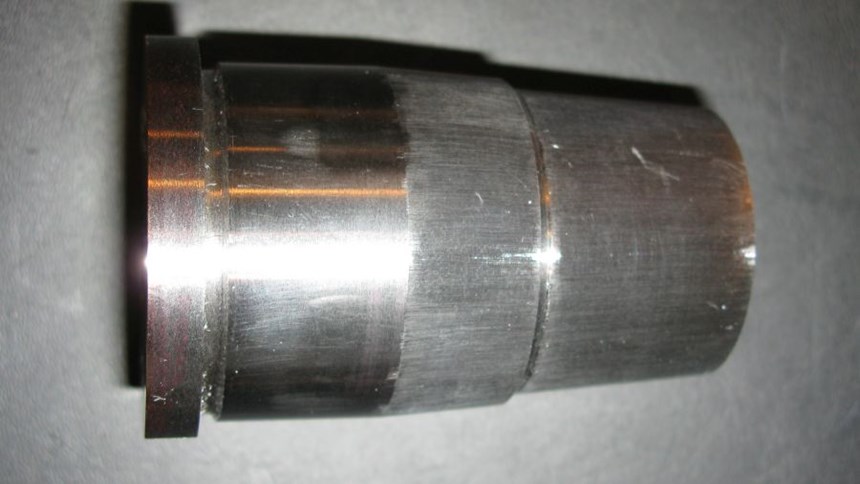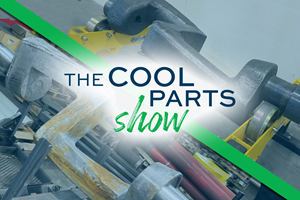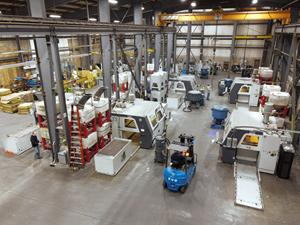Case Studies of Multi-Material Manufacturing
Tools for injection molding, die casting and powder compaction all illustrate the potential to achieve greater part performance and manufacturing efficiency by blending workpiece materials through AM.
Editor’s Note: Direct Metal Deposition (DMD) systems developed by DM3D Technology build metal parts by injecting powder into a weld pool created by a laser. One of the possibilities is multi-material manufacturing. A dual-hopper capability of these systems allows for controlled deposition of multiple materials on a single part. This means, for example, that a part can be designed and created to offer high toughness at the core combined with fatigue, wear or corrosion resistance resulting from some different material at the surface. DM3D’s Bhaskar Dutta reports on the following case studies illustrating some of the applications of multi-material manufacturing.
Case Study I: Injection Mold Tooling
Figure 1 in the sequence of illustrations above shows the shows cycle time breakdown typical of plastic part molding. As the diagram shows, part cooling time after plastic injection affects the total cycle the most (44 percent), meaning a reduction in cooling time would have greatest impact on productivity. Figure 2 shows a tool used for making seat belt clamps in cars. The tool has been made from tool steel cladded on a copper base using DMD. The thermal conductivity of copper alloys is almost 6.0 times that of tool steels. This conductivity allows the copper base to work as a heat sink, providing fast cooling of the part for a significant reduction in cycle time. Meanwhile, the steel clad on the molding surface provides the required strength and wear resistance of the tool.
The key to this cladding is successful joining of copper and steel. Conventional welding techniques can’t join these materials together. DMD joins them with a laser thanks in part to a proprietary buffer material. Figure 3 is a microscopic view of this cladding showing the buffer.
The steel-clad technology allowed this customer to reduce molding cycle time by 26 percent, achieving a 28-second cycle instead of 38 seconds with a conventional tool. That cycle time reduction translated to about $60,000 in savings per year per tool.
Case Study II: Die Casting Tooling
This work was performed in collaboration with Case Western Reserve University and the North American Die Casting Association.
Similar to injection molding, the efficiency of aluminum die casting is also affected significantly by part cooling time. The high temperatures and presence of liquid aluminum also pose other challenges to the tools. During casting, the core (usually made of tool steel) is surrounded by molten aluminum and overheats to the point that dissolution of the steel takes place (commonly called soldering in the die casting industry). Extracting heat more efficiently from the core can reduce the core temperature, prevent soldering and allow shorter cycle times. Figure 4 in the images above shows the aluminum part that was investigated in this study. Figures 5 and 6 show the composite core, which was made of copper alloy DMD-cladded with H13 tool steel using an intermediate buffer layer.
Figure 7 shows thermal imaging used to evaluate this composite core. Surface temperature was measured to be about 100oF lower than that of the conventional core. The benefits seen were a 13 percent reduction in casting cycle time (40 seconds for the H13/copper core versus 55 seconds for the purely H13 core) along with reduced soldering due to lower core temperature.
Case Study III: Powder Compaction Tooling
Powder compaction tools used in sintering undergo significant load cycling. Fatigue life of these tools is critical. Depending on the part design, a sharp radius in the tool geometry can act as stress concentrator, affecting the tool life significantly. Multi-material manufacturing technology offers an unusual solution for this problem. An alternate layering of hard metal and soft metal in the upper part of the tool is proposed to mitigate this stress-concentration problem. The lead photo in the series of illustrations above shows a sample of this. Fatigue cracks that arise at stress concentration points on the surface will be arrested when they propagate into the soft metal layer, while the presence of alternate hard metal layers provides the tool with the required stiffness and strength for metal compaction. This tooling technology is expected to aid in mitigating fatigue life problems with powder compaction tools.
Related Content
3D Printing Method for Complex Metal-Plastic Composite Structures
Researchers from Japan and Singapore have developed a new 3D printing technique to create precise patterns on the external and internal surfaces of 3D plastic structures.
Read MoreRobot Deposition Makes Giant Industrial Mixer Blade: The Cool Parts Show Bonus
Wire arc additive manufacturing produces a large component formerly made through casting, and allows for redesign of its internal cooling geometry.
Read MoreAM 101: What Is Hot Isostatic Pressing (HIP)? (Includes Video)
Hot isostatic pressing has long been used for metal castings, but is now being applied as a valuable method for closing porosity in metal 3D printed parts.
Read MoreLooking to Secure the Supply Chain for Castings? Don't Overlook 3D Printed Sand Cores and Molds
Concerns about casting lead times and costs have many OEMs looking to 3D print parts directly in metal. But don’t overlook the advantages of 3D printed sand cores and molds applied for conventional metal casting, says Humtown leader.
Read MoreRead Next
Hybrid Additive Manufacturing Machine Tools Continue to Make Gains (Includes Video)
The hybrid machine tool is an idea that continues to advance. Two important developments of recent years expand the possibilities for this platform.
Read More3D Printing Brings Sustainability, Accessibility to Glass Manufacturing
Australian startup Maple Glass Printing has developed a process for extruding glass into artwork, lab implements and architectural elements. Along the way, the company has also found more efficient ways of recycling this material.
Read MoreAt General Atomics, Do Unmanned Aerial Systems Reveal the Future of Aircraft Manufacturing?
The maker of the Predator and SkyGuardian remote aircraft can implement additive manufacturing more rapidly and widely than the makers of other types of planes. The role of 3D printing in current and future UAS components hints at how far AM can go to save cost and time in aircraft production and design.
Read More
